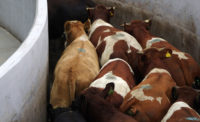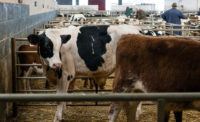Fifty-six copies of enforcement letters have been posted to the FSIS Humane Handling Web site in 2013. A review of these letters underscores the importance of a systematic approach to animal welfare and helps identify common issues to resolve.
Summary
The 56 enforcement actions that were posted to the FSIS Web site represent four livestock species: beef, pork, sheep, and goats. The majority (89.3%, 50/56) of the enforcement actions were taken in beef and pork plants. As far as red-meat slaughter goes, pork and beef are the two most common groups of livestock that are slaughtered in the U.S.
Two primary options for humane-handling enforcement actions have been used by the FSIS. One choice is a suspension, which results in a suspension of inspection services until the identified issue is addressed, a response is drafted that is reviewed by the district office, and inspection is reinstated.
The second option is a Notice of Intended Enforcement (NOIE). This enforcement action is more of a warning that an issue exists and must be addressed. An NOIE does not typically result in the type of long-term inspection stoppage that a suspension does, but it can if the plant does not take corrective action.
FSIS Directive 6900.2 Revision 2 explained the grounds for issuing a NOIE instead of a suspension due to a humane-handling infraction. The NOIE was recommended for instances where a slaughter establishment had installed a robust systematic approach to animal welfare and the infraction was an anomaly considering the facility’s historical record.
As of Nov. 17, 2013, 76.8% of enforcement actions were suspensions and 23.2% were NOIEs.
The Humane Slaughter Act of 1978 (7 U.S.C. §§ 1901) and the regulations that enforce it (9 CFR 313) provide the core set of rules that must be followed by slaughter establishments. The regulations in 9 CFR 313 can be divided into three primary categories: 1) Stunning, 2) Handling, and 3) Facilities. If we sort the 56 enforcement actions into these three categories, we find that 83.9% (47) enforcement actions were stunning-related and 16.1% (9) were a result of handling issues. No facility-related suspensions or NOIEs had been issued at the time this article was sent to press.
Handling
Of the nine handling-related incidents, three involved abusive handling by livestock transporters. It is the plant’s choice to assign company personnel to unload trailers or allow truckers to the complete the task.
In either case, abusive handling — which includes kicking, excessive electric prod use and electric prodding to sensitive areas of the body, and misuse of handling aids and other tools such as shovels and metal posts — absolutely cannot be tolerated. Once a load of livestock is waiting in line to unload at a slaughter establishment, the establishment takes responsibility for the animals on board. Regardless of who is selected to unload animals, they must be trained and supervised.
Two enforcement actions documented driving of animals over top of non-ambulatory animals. It is important that animals that become non-ambulatory are euthanized and then moved before driving livestock around them, or appropriate protection is provided to prevent them from being trampled. In some cases, a second handler can stand near the non-ambulatory animal to prevent trampling, but care must be taken to prevent injury to the handler as well.
Stunning
Eighty-three percent (39 of 47) of stunning-related violations included multiple ineffective stuns with captive bolt guns and/or firearms. Well-maintained captive bolt guns and firearms that provide enough power and are operated by well-trained personnel are highly effective tools for pre-slaughter stunning or the humane euthanasia of livestock.
Three important components to effective stunning with firearms are training for shot placement and device operation, maintenance of the device, and appropriate restraint of the animal. The Humane Slaughter Act requires that animals are rendered unconscious with a single shot and then kept unconscious throughout the slaughter process.
Stunning efficacy is one of the places where a systematic approach to animal welfare can prove its value. Part of the systematic approach includes monitoring critical activities in the handling and stunning process to develop a data set that can be used to verify compliance with humane-handling and stunning requirements.
Take a systematic approach
In September of 2011, the FSIS issued Directive 6900.2 Revision 2. This document was focused on defining humane-handling and stunning expectations for federally inspected slaughter establishments. A significant component of the document was the recommendation for each slaughter establishment to develop a “robust” systematic approach to animal welfare.
A systematic approach is essentially a HACCP plan for compliance with the Humane Slaughter Act and 9 CFR 313. In order for a systematic approach to be classified as “robust”, the following criteria must be met:
- Conduct an initial assessment of where, and under what circumstances, livestock may experience excitement, discomfort or accidental injury while being handled in connection with slaughter, and of where, and under what circumstances, stunning problems may occur;
- Design facilities and implement practices that will minimize excitement, discomfort and accidental injury to livestock;
- Evaluate periodically the handling methods the establishment employs to ensure that those methods minimize excitement, discomfort or accidental injury, and evaluate those stunning methods periodically to ensure that all livestock are rendered insensible to pain by a single blow; and
- Respond to the evaluations, as appropriate, by addressing problems immediately, and by improving those practices and modifying facilities when necessary to minimize excitement, discomfort and accidental injury to livestock.
One of the benefits to installing a systematic approach to animal welfare is the potential for an event that would have historically resulted in a suspension of inspection to be addressed with a NOIE if the event is considered an anomaly and the facility has appropriately addressed the potential issue in their systematic approach and followed through on the corrective action that the systematic approach recommends.
The greater benefit of the systematic approach can be recognized by many of the slaughter facilities that have not been the subject of humane-handling enforcement actions this year — it helps to maintain the focus on monitoring stunning and handling procedures and taking action before major problems arise.






Report Abusive Comment